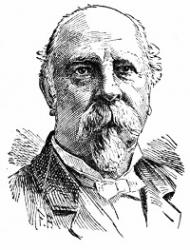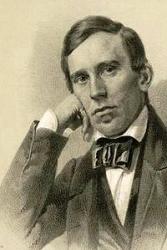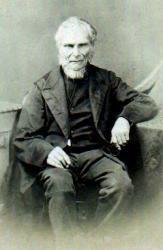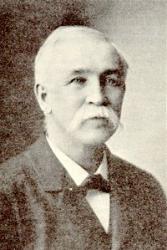Planning worship?
Check out our sister site, ZeteoSearch.org,
for 20+ additional resources related to your search.
- |
User Links
Person Results
‹ Return to hymnal




Export as CSV
Sidney Dyer
1814 - 1898 Hymnal Number: 276 Author of "Work, for the Night is Coming" in Pentecostal Hymns No. 3 Dyer, Sidney, who served in the U. S. Army from 1831 to c. 1840, is a native of White Creek, Washington County, New York, where he was born in 1814. On leaving the army he was ordained a Baptist Minister in 1842, and acted first as a Missionary to the Choctaws, then as Pastor in Indianapolis, Indiana (1852), and as Secretary to the Baptist Publication Society, Phila. (1859). He has published sundry works, and in the Southwestern Psalmist, 1851, 16 of his hymns are found.
The following are later and undated:—
1. Go, preach the blest salvation. Missions. In the Baptist Praise Book, 1871, and The Baptist Hymn & Tune Book, 1871.
2. Great Framer [Maker] of unnumbered worlds. National Humiliation. In the Boston Unitarian Hymn [and Tune] Book, 1868, and others.
3. When faint and weary toiling. Work whilst it is day. In the Baptist Praise Book, 1871.
4. Work, for the night is coming. Duty. This hymn is in wider use than the foregoing, but though often ascribed to Dyer, is really by Miss Anna L. Walker, of Canada, who published a volume of Poems, 1868. S. Dyer, in 1854, wrote a hymn on the same subject for a Sunday-school in Indianapolis, and hence the confusion between the two. In 1882 a cento beginning with the same stanza was given in Whiting's (English) Hymns for the Church Catholic, No. 366. Of this cento, stanzas i., ii. are by Miss Walker; and stanzas iii., iv. by Miss Whiting, daughter of the editor of that collection. [Rev.F. M. Bird, M.A.]
-- John Julian, Dictionary of Hymnology (1907)
==================
Dyer, S., p. 317, ii. Additional hymns by Dr. Dyer are given in the Baptist Sursum Corda, Phila., 1898, with the following dates :—
1. Enter, Jesus bids thee welcome. Invitation. 1883.
2. No more with horrors veil the tomb. Burial. 1897.
Dr. Dyer d. in 1898.
--John Julian, Dictionary of Hymnology, New Supplement (1907)
=================
Dyer, Sidney. (White Creek, New York, February 11, 1814--December 22, 1898, Philadelphia). Baptist. Indiana State University, honorary A.M. ; Bucknell University, honorary Ph.D. Missionary to the Choctaws early in his career. Pastorates at Brownsville, New York, 1842; Indianapolis, 1852-1859. District secretary of the American Baptist Publication Society, Philadelphia, 1859-1885. Author of eight religious books designed for children, two volumes of verse: Voices of Nature (Louisville, 1849), and Songs and Ballads (Indianapolis, 1857). Wrote a large number of hymns in Sunday School as well as church collections. In 1851, he published The South Western Psalmist (Louisville), which became known as Dyer's Psalmist. Of 467 hymns, 16 are by Dyer. Also wrote a prize-winning hymn "O wondrous land! thy onward march sublime" for the Jubilee of the American Baptist Home Mission Society which was help in New York in 1882. This 66-stanza hymn may be found in Baptist Home Missions in North America: Including a Full Report of the Proceedings and Address of the Jubilee Meeting . . . (New York: Baptist Home Mission Rooms, 1883). "Work, for the night is coming," written by Annie L. (Walker) Coghill, was sometimes ascribed to Dyer. The confusion arose when, in 1854, Dyer wrote a text on the same subject for a Sunday School in Indianapolis.
--Deborah Carlton Loftis, DNAH Archives
Sidney Dyer
E. D. Mund
Hymnal Number: 91 Author of "Thou Thinkest, Lord, of Me" in Pentecostal Hymns No. 3 Pseudonymn. See also Lorenz, Edmund S. (Edmund Simon), 1854-1942
E. D. Mund
Clara Tear Williams
1858 - 1937 Person Name: Clara Teare Hymnal Number: 93 Author of "Satisfied" in Pentecostal Hymns No. 3 Williams, Mrs. Clara Tear. (Painesville, Ohio, September 22, 1858--July 1, 1937, Houghton, New York). As a young woman she was a school teacher. She suffered an attack of tuberculosis but fully recovered from it and for a number of years engaged in evangelistic work in several North Central states. In 1895 she married the Reverend W.H. Williams, a Wesleyan Methodist minister, and until his death thirty years later labored with him in serving churches in New York, Ohio, and Pennsylvania. She was a member of the Commission of her church which compiled Sacred Hymns and Tunes, 1897.
--Robert G. McCutchan, DNAH Archives. Photocopied photos (uncited) of Clara Tear Williams and pages from a manuscript family history by Frank W. Tear are also available in the DNAH archives.
==========================
Rev. Mrs. Clara Tear Williams was a pastor and evangelist. From what records are available, it appears that she affiliated with the Wesleyan Methodist Church in the 1880s. The information suggests that she was a Licensed Minister, but never ordained. She served on the Committee to compile the WMC hymn book, "Sacred Hymns and Tunes" in 1897. She married William H. Williams in 1895 whom she had met while conducting meetings in Middlefield, Ohio. He had been widowed in 1881. He joined her in the ministry, the first mention of him in the Pastoral Relations Report being in 1901. He died May 17, 1934 in Houghton, New York.
According to Mrs. Williams' obituary, she was connected with the Allegheny and Lockport Conferences of the Wesleyan Methodist Church. No reference was found to her in the Minutes of the Lockport Conference, but she was mentioned in the Minutes of the New York Conference. Though there is no body of minutes available for the early years of the Allegheny Conference, Mrs. Williams can be found in the Statistical and Pastoral Relations reports sent to The Wesleyan Methodist. The following information is taken from those sources.
Allegheny Conference/New York Conference, WMC:
1886-1887: Clara Tear is assigned by the Allegheny Conference to serve as Evangelist at Large, and to Concord, Ohio.
1888: No mention found at either Conference.
1889: Clara Tear is on the Licentiate List for the Allegheny Conference, no assignment; she is present at this year's session of the New York Conference and introduced as being from the Allegheny Conference.
1890: Listed as an Evangelist at Large for the Allegheny Conference; present at the New York Conference and listed as a lay delegate and General Missionary.
1891: On the Licentiate List for the Allegheny Conference but no assignment given; present at the New York Conference, her name was called, character passed, and License renewed; she reported she had been in evangelistic work, then had taken charge of the work at Lake Hill for the remainder of the year; she is listed as a General Evangelist and was elected as a lay delegate to the 1891 General Conference.
1892: General Evangelist for the Allegheny Conference.
1893 Assigned to supply the pulpit at Keepville, Pennsylvania and General Evangelistic work.
1894: Assigned to care for Middlefield, Ohio; General Evangelist.
1895: General Evangelist; elected as a lay delegate to the General Conference.
1896-1899: General Evangelist.
1900: Assigned to Pine Grove, Pennsylvania.
1901: Clara T. and W.H. Williams to supply Indiana, Pennsylvania.
1902-1904: Joint assignment to Pine Grove, Penn.
1905-1907: Joint assignment to Canton, Ohio.
1908-1916: Joint assignment to Massillon, Ohio.
1917: Both to supply Middlefield, Ohio.
1918-1919: Join assignment to Pine Grove, Penn.
1920- : Both are listed as Superannuated.
--Information supplied by The Wesleyan Church Archives and Historical Library, 26 February 1996. Also includes photocopy of obituary from The Wesleyan Methodist 28 July 1937. DNAH Archives.
Clara Tear Williams
Henry Godden Jackson

1838 - 1914 Person Name: H. G. Jackson Hymnal Number: 19 Author of "We're on the Way to Canaan's Land" in Pentecostal Hymns No. 3 Born: January 1, 1838, Manchester, Indiana.
Died: November 12, 1914.
A Methodist minister, Jackson and his wife Alice spent many years as missionaries in Buenos Aires, Argentina. Upon their return to America, they lived in the River Forest/Oak Park area of Chicago, Illinois.
--www.hymntime.com/tch
Henry Godden Jackson
J. Edward Ruark
Person Name: J. Edw. Ruark Hymnal Number: 70 Author of "You May Have the Joy-Bells" in Pentecostal Hymns No. 3
J. Edward Ruark
M. L. McPhail
Hymnal Number: 161 Arranger of "[I am on a shining pathway]" in Pentecostal Hymns No. 3
M. L. McPhail
Stephen Collins Foster

1826 - 1864 Person Name: Stephen C. Foster Hymnal Number: 115 Composer of "[O ye thirsty ones that languish on life's drifting sand]" in Pentecostal Hymns No. 3
Stephen Collins Foster
John Burton

1803 - 1877 Person Name: John Burton, Jr. Hymnal Number: 275 Author of "Savior, While my Heart is Tender" in Pentecostal Hymns No. 3 Burton, John, jun, a popular hymn-writer for children, was b. July 23, 1803, at Stratford in Essex, in which place he carried on business as a cooper for about 50 years. He died in 1877. Mr. Burton was a member of the Congregational body, and a Deacon of the Chapel where he attended, His contributions to hymnody began in 1822, when he sent his first production to the Evangelical Magazine. He continued to contribute to that and other periodicals for many years, his signature in the former being "Essex, J. B.," and in the Child's Companion, J. B. Essex." His publications are:—
(1) One Hundred Original Hymns for the Young, 1850; (2) Hymns for Little Children, 1851; (3) The Child-Life of David; (4) The Book of Psalms in English Verse, 1871; (5) Scripture Characters in Verse, &c.
His Hymns for Little Children, containing 54 pieces, has been republished in Philadelphia, U.S.A., as My Own Hymn Book. He also contributed to the Union Hymn Book for Scholars, 1840. Some of his hymns have attained a measure of popularity, including “Thou that nearest prayer," "Come, let us sing our Maker's praise," and many others. In addition, the following are also in common use:—
1. Children who are gone to glory. Saints' days.
2. Children, you have gone astray. Invitation. Published in the Child's Companion, April, 1834, and his One Hundred Hymns, 1850, &c.
3. Come, let us sing our Maker's praise. For Orphans. In his One Hundred Hymns, 1850, No. 86, in 6 stanzas of 4 lines.
4. Father of mercies, hear; On us, &c. Influence implored. In his One Hundred Hymns,1850, No. 97, in 6 stanzas of 4 lines; and partly rewritten in 2 stanzas of 8 lines. In Kennedy, 1863, No. 1209, beginning: "Father Of mercies, hear The song Thy children raise.
5. God is love, delightful truth. Love of God. Published in the Child's Companion, Aug., 1835, and again in his One Hundred Hymns, 1850, No. 20, in 5 stanzas of 4 lines. It is given in the Silver Street Sunday School Hymn Book 1880.
6. Happy would it be for me. Early Piety.
7. Hark! a still small voice is heard. Christ's love for Children. This appeared in the Child's Companion, July, 1836, and the revised edition of the Union Hymn Book,&c, 1850, No. 14, in 4 stanzas of 6 lines. It is in various collections, including the Methodist Sunday School Hymn Book, 1879, and others.
8. Heavenly Father, we draw near Thee. Sunday Schools. Published in his One Hundred Hymns,1850, &c.
9. I often say my prayers. Prayer. Also from the Union H. Book, I84o; into Major's Bk. of Praise, &c.
10. None is like God, who reigns above. Omnipresence. Dated 1849, and given in his One Hundred Hymns, No. 4, in 5 stanzas of 4 lines. It is reprinted in several school collections, as Stevenson's School Hymnal, 1880, No. 139.
11. Pilgrims we are and strangers. Life a Pilgrimage. From the Evangelical Magazine, 1829, 5 stanzas of 8 lines, commencing “Now let our praise be given," and headed "The Pilgrim's Song," into the Baptist Psalms & Hymns, 1858, No. 553, in 4 stanzas of 8 lines, st. i. being omitted.
12. Remember thy Creator now. Early Piety. From the Child's Companion, Sept. 1833, into his One Hundred Hymns, 1850, and the Methodist Sunday School Hymn Book, No. 243.
13. Saviour, while my heart is tender. Early Piety. Also from the One Hundred Hymns. It is in the Baptist Hymnal, 1879; Horder's Congregational Hymns, 1884; and others.
14. That kind eye which cannot sleep. Omniscience. But little known.
15. The Lord attends when children pray. Prayer. 1st printed in the Child's Companion, July, 1835, and again in Dec. 1837, and in the revised edition of the Union Hymn Book, 1840; and his One Hundred Hymns, 1850, No. 31, in 5 stanzas of 4 lines. It is in several collections, including Dr. Allon's Children's Worship, 1878, &c.
16. Though we are young our sins are great. Lent. In the revised edition of the Union Hymn Book, 1840; and his One Hundred Hymns, 1850 (in the latter as "Though I am," &c), No. 9, in 6 stanzas of 4 lines. It is included in Major's Book of Praise, &c.
17. We do not love Thee as we ought. Lent. In the Methodist Sunday School Hymn Book, 1879, No. 286.
18. Why did Jesus come from heaven? Passiontide. From his One Hundred Hymns, 1850, No. 61, in 4 stanzas of 6 lines, into Major's Book of Praise.
19. Why should we spend our youthful days? Youthful Piety. Printed in the Child's Companion, May, 1835, in his One Hundred Hymns, 1850, and as No. 252 in the Methodist. Sunday School Hymn Book, 1879.
--John Julian, Dictionary of Hymnology (1907)
John Burton
Theodore E. Perkins

1831 - 1912 Person Name: T. E. Perkins Hymnal Number: 304 Composer of "[Come, needy sinners, Jesus is waiting]" in Pentecostal Hymns No. 3 Theodore E. Perkins was born at Poughkeepsie, on the Hudson, N.Y., July 21, 1831. His father was a Baptist clergyman. The family of ten brothers and sisters sang and played various instruments, forming among themselves both choir and orchestra. His musical education began at the early age of three years. During his father's pastorate at Hamilton, N. Y., the choir rehearsals were often held at the parsonage, and the leader used to place the three-year-old on a small stool, on the table around which the choir was assembled, giving him a chance to both see and hear. Later on he played the violincello in church, standing on a stool in order to finger the instrument.
The home gatherings — especially on Thanksgiving Day, are the recollections among the happiest of his childhood. His father became pastor of the Berean Baptist Church in New York City, in 1839, giving him the opportunity of studying the pianoforte, of which he became a proficient player. His fine alto voice soon gave him notoriety. At the age of nineteen while filling a position as clerk in New York, all his spare time was given to the study of voice and piano. In 1851 he went to Hamilton, N. Y., taught music in Madison University (now Colgate), and in the Female Seminary.
In 1854 he went to Port Jervis, N. Y., where he taught singing school, and April 30, 1855, married Mary Frances Caskey, who was for years his soprano soloist in many musical Festivals and Conventions. Soon after marriage he removed to Salem, N. J., where his lifework as singing school teacher really began, including Bridgeton and prominent towns in southern New Jersey. During the summer of 1856 he and his wife were pupils of the Normal Academy of Music at North Reading, Mass., conducted by Drs. Lowell Mason and Geo. F. Root. During 1856-1858 he was given the position of assistant teacher and manager. His association with these two great men gave an inspiration to all his future work.
In 1859 he was co-principal with Wm. B. Bradbury at the Normal Academy of Music, Geneseo, N. Y. He remained at Geneseo until 1863. Professor Perkins also held very successful schools in North Pelham Province of Ontario, Canada, and in 1864-1868 was principal in schools at Tunkhannock and Meadville, Pa.
In 1860, The Olive Branch, his first book of church music, was published by F. J. Huntington, New York City, the sales reaching 100,000. Next was Oriental, which sold over 30,000. The Union, Glees and Anthems, and Sabbath Anthems followed ; then The Sacred Lute, which sold over 300,000. His Sunday-school books commenced with The Evergreen, followed by the Shining Star and New Shining Star. Then came Psalm King, which was the last of the books published by Mr. Huntington. Hallowed Songs was published by Philip Phillips; The Sunday School Banner was published by Wm. B. Bradbury. The Royal Standard was published in Toronto, Canada. The Golden Promise, Sabbath Carols, The Mount Zion Collection were published under his own supervision.
His Free Sunday School Songs several times numbered over 500,000 a month. Coronation Songs with Rev. Dr. Deems as hymn editor was published by A. S. Barnes Co., who also published Psalms and Hymns and Spiritual Songs, in which Dr. C. S. Robinson was hymn editor, who with Professor Perkins edited Calvary Songs, published by the American S. S. Union. Gospel Tent Songs was evangelical. The Safe-Guard Singer was his temperance book.
Mr. Perkins was musical director in the following churches in Brooklyn: The Lafayette Avenue Presbyterian Church, Rev. Dr. Cuyler; Strong Place Baptist Church, Rev. E. E. L. Taylor, D. D.; Madison Avenue Baptist Church, Rev. H. G. Weston, D. D., L. L. D.; Fifth Avenue Presbyterian Church, Rev. Dr. Rice, followed by Dr. John Hall; The Memorial Presbyterian Church, Rev. Dr. C. S. Robinson, who was his close friend; The Church of the Holy Trinity, Rev. Dr. Tyng, Jr. ; Trinity Baptist Church, Rev. Dr. J. B. Simmons, and Washington Square M. E. Church.
In Philadelphia: The Fifth Baptist Church, Rev. Dr. Chase; The Eleventh Baptist Church, Rev. Dr. Colman; The Tabernacle M. E. Church, Rev. George Gaul, D. D. He was leader and singer in Evangelistic Services, at the Rink, The Old Madison Square Garden and Cooper Union, all of New York City. The music of the first great meeting of the world's Evangelical Alliance, held for ten days in New York City, was under his direction, as was the first National Sunday School convention, held in Newark, N. J. He was also conductor at the Golden Anniversary of the Female Guardian Society, leading a chorus of forty-two hundred children. In the opening chorus, Great is the Lord, by Dr. Calcott, the word "Great" was given with so much decision and power that the clergymen on the platform sprang to their feet and remained standing until the chorus was finished.
He taught voice culture in Princeton and Lafayette Universities, The Union Theological Seminary, New York City; Crozer Seminary, Chester, Pa., and organized the music department of Temple University, Philadelphia, continuing in charge four years. He had charge of the children's choir of Howard Mission, New York City, for twenty-five years, and thinks that some of the happiest and most restful of the working hours were spent in teaching the poor children of the fourth and sixth wards to sing the Gospel. Mr. Sankey said to Mr. Perkins that " Jesus of Nazareth was my banner song for eight years." Jesus is Mine has been sung at the Christian's death-bed, the grave, and once as the convict was going to the scaffold.
His Christmas Carol Sweetly Carol had a very large sale in this country, and was republished in England, France, Italy, and Germany.
For a period of forty years he has made the study of the voice special work. The most thorough investigations of the voice and its possibilities were made with the assistance of the late John Howard, extending over a period of twenty-five years, during which he has had the care of over two thousand voices. He published a work entitled, Physiological Yoice Culture, edited by his son, the late T. Edward Perkins, M. D., physician and throat specialist of Philadelphia. Mr. Perkins also completed a method of voice culture based on the principles of John Howard's Physiology of Artistic Singing."
During these years of work he has found time to edit thirty-four books of church, Sunday-school, day-school, and glee music, the larger portion having been previously mentioned. Also songs and ballads in sheet form, and a cantata entitled, The Excursion, libretto by Fanny Crosby, with whom there has existed an unbroken friendship for over forty years.
-Biography of Gospel Song and hymn Writers
Theodore E. Perkins
J. A. Wallace
1802 - 1870 Person Name: John A. Wallace Hymnal Number: 237 Author of "An Eye That Never Sleeps" in Pentecostal Hymns No. 3 Wallace, John Aikman, born in Edinburgh, Jan. 19, 1802; minister of the Free Church of Scotland at Hawick, and died at Trinity, near Edinburgh, Feb. 9, 1870.
--John Julian, Dictionary of Hymnology, Appendix, Part II (1907)
J. A. Wallace


 My Starred Hymns
My Starred Hymns

